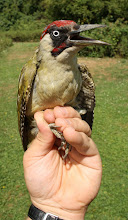This will be the last in my series of photographs of Sardinian birds. I've not run out of photographs, it's just that it would get a bit repetitive if I shared any more (and really out of date!).
I'm also expecting the bird ringing to pick up (first juveniles of Robin, Dunnock, Blackbird, Chaffinch and Great Spotted Woodpecker have been ringed), especially as the juveniles are beginning to fledge - even if the wind is reducing the catch or preventing me from getting out at all. There is news on the ringing front to come soon, but first:
Above: Bee-Eaters. We saw a number of these and found that they prefer cultivated land.
Above: Grey Wagtail. Seen by the spring at Su Goroppu (a gorge), this bird was very showy (presumably well used to lots of people as this is a very well visited site).
Above: Grey Wagtail. The hole in the rock above the bird was, presumably, a nest site as the bird disappeared inside for more than a minute (either that or a good source of insects!).
Above & Below: Flamingo. Strange looking birds, but nice to see in the wild. The pink in the wing is striking when seen in flight when they look almost comical!
I observed the birds appearing to scrape the bottom of the lake with their feet whilst feeding (presumably to disturb the food making it easier to catch - interesting behaviour. They also, from time to time, had arguements (either this or displaying to eachother) - puffing up the feathers on their back (almost swan like) and gesturing with their neck - occasionally making contact with bills.
The holiday in Sardinia started and finished with this species and is therefore a good place to end.


























































